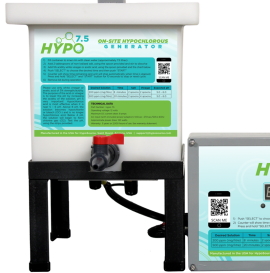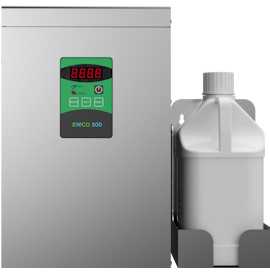About Hypochlorous Acid

Hypochlorous acid can also be produced through a process called electrolysis. Electrolysis is a technique that uses a direct electric current (DC) to drive an otherwise non-spontaneous chemical reaction. Specifically engineered elecrolysis cells can generate a solution of free chlorine species by running electricity through NaCl (table salt) and water. The oxidants hypochlorous acid (HOCl) and hypochlorite (OCl-) are formed at the anode. If the pH of the solution is weakly acidic to neutral, the free chlorine solution will be dominated by hypochlorous acid.
Best Hypochlorous Acid (HOCL) Generators
 Portable Hypochlorous Acid (HOCL) Machine
Portable Hypochlorous Acid (HOCL) Machine
Make high quality hypochlorous acid in the home or office.
$159.99 + Free Shipping
 HOCL Machine + Electrostatic Sprayer
HOCL Machine + Electrostatic Sprayer
Make hypochlorous acid and spray with an electrostatic cold fogger.
$309.98 + Free Shipping
New Technology & Research
The use of chlorine for disinfection has been researched for over 100 years. It has been an undisputable fact that hypochlorous acid offers far superior disinfecting properties than sodium hypochlorite (chlorine bleach). One of the most well known authorities for the use of chlorine as a disinfectant is White's Handbook of Chlorination. This book is comprehensive in explaining the chemistry and effectiveness of chlorine and alternative disinfectants.
The challenge has been in engineering a system for producing a free chlorine solution that is dominated by the molecule of hyopchlorous acid (HOCl) rather than sodium hypochlorite (NaOCl-). The development of electrolysis cells for generating electrolyzed water became a huge innovative breakthrough in the 1970s. Since then, improvements in electrolysis cells have been made that can generate a solution of free chlorine that is near 99% hypochlorous acid and that is stable.
One of the most recent improvements has been the development of single cell technology to replace membrane cell technology allowing for the production of just one stream of solution at a near neutral pH. Prior technology used membranes and high pressures that forced two streams to be generated, an unstable anolyte of hypochlorous acid and an unstable catholyte of sodium hydroxide. With the development of single cell technology, a stable solution of just anolyte can be produced yielding a solution of near 99% stable hypochlorous acid.
Over 30 years of research exisits for the use of hypochlorous acid and new research is being published every year. Recent research has focused on the use of hypochlorous acid for sanitzing food and food processing facilities. Research has also been done on poultry farms, water treatment and disinfection, and healthcare related applications such as wound care and equipment sterilization.
Search over 300 published research articles on the use of hypochlorous acid.
Research DatabaseSafe on Eyes and Skin
Hypochlorous acid does not cause irritation to eyes and skin. Even it were ingested it causes no harm. Because it is so safe, it is the ideal sanitizer for direct food sanitation and food contact surfaces. It is also ideal in healthcare where it is used for wound cleansing, eye drops, and patient room disinfection replacing toxic chemicals such as bleach and quaternary ammonium (quats).

Non-Toxic, Non-Hazardous
Sanitation chemicals distributed in concentrated form are toxic and can be hazardous. Contact with skin or inhalation of fumes can cause irritation. These risks do not exist with hypochlorous acid. Electrolyzed water systems generate hypochlorous acid from just table salt, water and electricity. No personal protective gear is required.

How does HOCl kill microbial pathogens?
Disinfectants and microbial pathogens interact with each other similar to magnets. If you bring together two negatively charged magnets, they will repel each other. Bacteria and hypochlorite (OCl- aka. bleach) are both negatively charged and behave like two negatively charged magnets repelling each other. Hypochlorous acid (HOCl) is neutrally charged and is not repelled by bacteria. HOCl easily penetrates the walls of the bacteria and destroys them with its strong oxidation potential.
Why is pH important?
A free available chlorine (FAC) molecule is one that is not attached. There are three forms of free available chlorine: chlorine gas, hypochlorous acid and hypochlorite. Assuming a constant temperature of 25 degrees Celsius, when the pH is below 3, free chlorine will leave solution as chlorine gas. When the pH is above 7.5, over 50% will be hypochorite (OCl-) and will increase in hypochlorite as it rises toward pH 14. Between pH 3 and pH 7.5 the free chlorine solution will be dominated by hypochlorous acid (HOCl).







